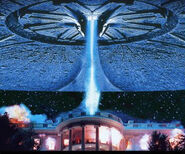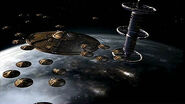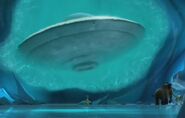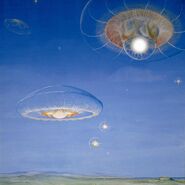No edit summary |
|||
| (22 intermediate revisions by 7 users not shown) | |||
| Line 1: | Line 1: | ||
| ⚫ | |||
| − | {{Stub}} |
||
[[File:FlyingSaucers.jpg|300px|thumb]] |
[[File:FlyingSaucers.jpg|300px|thumb]] |
||
| ⚫ | |||
'''Flying Saucers''' are a commonly used form of transportation by various intelligent species. |
'''Flying Saucers''' are a commonly used form of transportation by various intelligent species. |
||
| + | ==History== |
||
| − | Although objects like these have been observed in the skies throughout all of human history, with well documented examples dating back to the medieval ages at least; the term has |
+ | Although objects like these have been observed in the skies throughout all of human history, with well documented examples dating back to the medieval ages at least; the term has become extremely popular since the later half of the 20th century, and is often used interchangeably with U.F.O., both terms having become virtually synonymous with "alien spacecraft", although neither is supposed to mean specifically that. Curiously, the name "flying saucer" was first coined in 1947 to refer to a formation of nine unidentified flying objects (UFOs) observed by aviator Kenneth Arnold while in flight; even though the objects described by Arnold were actually shaped more like crescents. |
| − | The |
+ | The concept of saucer-shaped flying craft has also been researched by multiple agencies on Earth as well; and many people still hold the belief that at least some UFO sightings originate in man-made objects that have been kept secret from the public. Another relatively popular explanation (especially among cryptozoologists) consists in the idea that at least some of the observed "flying saucers" are actually [[Atmospheric Beast|living organisms native to the higher layers of the Earth atmosphere]], and which seldom, if ever, touch the ground. This idea has been written upon in detail by Leonard Cramp, Trevor J. Constable, Ivan T. Sanderson and Karl Shuker, among many others. |
| − | ==Occurrences in |
+ | ==Occurrences in fiction== |
| − | ===Flying |
+ | ===Flying saucer users=== |
A list of species known to utilize this type of vessel for interplanetary travel: |
A list of species known to utilize this type of vessel for interplanetary travel: |
||
*[[Adipose]] (''Doctor Who'') |
*[[Adipose]] (''Doctor Who'') |
||
| + | *[[Alien (A Centaur's Life)|Aliens]] (''A Centaur's Life'') |
||
*Aliens (''Earth Vs. the Flying Saucers'') |
*Aliens (''Earth Vs. the Flying Saucers'') |
||
| + | *[[Alien (Gadget and the Gadgetinis)|Aliens]] (''Gadget and the Gadgetinis'') |
||
*[[Independence Day Aliens|Aliens]] (''Independence Day'') |
*[[Independence Day Aliens|Aliens]] (''Independence Day'') |
||
| + | *[[Alien (Invasion of the Saucer Men)|Aliens]] (''Invasion of the Saucer Men'') |
||
| + | *[[Alien (Teenagers from Outer Space)|Aliens]] (Teenagers from Outer Space) |
||
| + | *[[Alphan (Starship Invasions)|Alphans]] (''Starship Invasions'') |
||
*[[Antarean]]s (''Cocoon'') |
*[[Antarean]]s (''Cocoon'') |
||
*[[Baltian]]s (''Men In Black'') |
*[[Baltian]]s (''Men In Black'') |
||
| Line 21: | Line 26: | ||
*[[Dexoid]]s (''Yogi and the Invasion of Space Bears'') |
*[[Dexoid]]s (''Yogi and the Invasion of Space Bears'') |
||
*[[Dominator]]s (''Doctor Who'') |
*[[Dominator]]s (''Doctor Who'') |
||
| − | *[[ |
+ | *[[Energy Beast]] (''The Godzilla Power Hour'') |
| + | *[[Frunobulaxian]]s (''Pinky and the Brain'') |
||
*[[Grey]]s (multiple occurrences in fiction, and possibly real life) |
*[[Grey]]s (multiple occurrences in fiction, and possibly real life) |
||
| − | * |
+ | *[[Hurrian]]s (''The Gentle Vultures'') |
| + | *[[Ice Warrior]]s (''Doctor Who'') |
||
*[[Kanamit]]s (''To Serve Man'') |
*[[Kanamit]]s (''To Serve Man'') |
||
| + | *[[Kilaak]]s (''Destroy All Monsters'') |
||
| + | *[[Luron]]s (''Doctor Who'') |
||
| + | *[[Martian (Devil Girl from Mars)|Martians]] (Devil Girl from Mars) |
||
*[[Martian (Mars Attacks!)|Martians]] (''Mars Attacks!'') |
*[[Martian (Mars Attacks!)|Martians]] (''Mars Attacks!'') |
||
| − | *Martians (''The Three Stooges'') |
+ | *[[Martian (The Three Stooges)|Martians]] (''The Three Stooges'') |
*[[Nedenah]] (''Doctor Who'') |
*[[Nedenah]] (''Doctor Who'') |
||
| − | * |
+ | *[[Pairan]]s (''Warning from Space'') |
| + | *[[Prin]] (''The Lost World'') |
||
| + | *[[Rigellian (The Simpsons)|Rigellians]] (''The Simpsons'') |
||
*[[Slime Creatures from Outer Space|Slime Creatures]] (''Slime Creatures from Outer Space'') |
*[[Slime Creatures from Outer Space|Slime Creatures]] (''Slime Creatures from Outer Space'') |
||
*[[Vree]] (''Babylon 5'') |
*[[Vree]] (''Babylon 5'') |
||
*[[Xilien]]s (''Godzilla'' movies) |
*[[Xilien]]s (''Godzilla'' movies) |
||
| − | * |
+ | *[[Yargonian]]s (''Yargo'') |
| + | *[[Zeta Reticulan (Starship Invasions)|Zeta Reticulans]] (''Starship Invasions'') |
||
| − | ===Other |
+ | ===Other occurrences=== |
Other occurrences of flying saucers in fiction: |
Other occurrences of flying saucers in fiction: |
||
| + | *The ''Jupiter 2'', which carries the protagonists from the classic TV series ''Lost in Space'', is an example of an Earth ship that uses this design. |
||
| − | *In ''Star Trek'', many Federation ships are largely composed of a saucer-shaped section which can be separated from the rest, essentially becoming a flying saucer. This is most notably observed with the ''Enterprise'' in ''Star Trek |
+ | *In ''Star Trek'', many Federation ships are largely composed of a saucer-shaped section which can be separated from the rest, essentially becoming a flying saucer. This is most notably observed with the USS ''Enterprise''-D in ''Star Trek Generations''. |
*A flying saucer has been observed in the Tintin adventure ''Flight 747 to Sydney'', although the aliens responsible for it remain unseen. |
*A flying saucer has been observed in the Tintin adventure ''Flight 747 to Sydney'', although the aliens responsible for it remain unseen. |
||
*One such object is seen frozen in an ice cave in the animated comedy ''Ice Age''. |
*One such object is seen frozen in an ice cave in the animated comedy ''Ice Age''. |
||
| + | *The [[Qarasht]]eel use them, but not as starships, only as atmospheric probes. |
||
| + | *[[Mator's species]] consists of living, intelligent flying saucers. |
||
| − | ===Biological |
+ | ===Biological saucers=== |
Examples of such creatures in science fiction include: |
Examples of such creatures in science fiction include: |
||
*Some of the life forms described in Sir Arthur Conan Doyle's tale ''The Horror of Heights''. |
*Some of the life forms described in Sir Arthur Conan Doyle's tale ''The Horror of Heights''. |
||
*[[Star Jelly|The creatures from the pilot episode of ''Star Trek: The Next Generation'']]. |
*[[Star Jelly|The creatures from the pilot episode of ''Star Trek: The Next Generation'']]. |
||
| + | *[[Hedorah]], when in its flying form, somewhat resembles an organic flying saucer. |
||
==Gallery== |
==Gallery== |
||
| Line 54: | Line 71: | ||
SkyMedusa.PhilippaFoster.jpg|An artistic rendering of the biological saucers hypothesis, by Philippa Foster |
SkyMedusa.PhilippaFoster.jpg|An artistic rendering of the biological saucers hypothesis, by Philippa Foster |
||
</gallery> |
</gallery> |
||
| − | [[Category:Technology]] |
||
| − | [[Category:Illustrated Technology]] |
||
| − | [[Category:Spacecraft]] |
||
| − | [[Category:Vehicles]] |
||
[[Category:Multiple Universes]] |
[[Category:Multiple Universes]] |
||
[[Category:Concepts]] |
[[Category:Concepts]] |
||
| − | [[Category:Disambiguation Pages]] |
||
Revision as of 01:17, 25 March 2019
- "Well, flying saucer maybe, they were quite fashionable in the fifties. Just like bobby socks and hair cream."
- ―The Doctor, Dreamland.
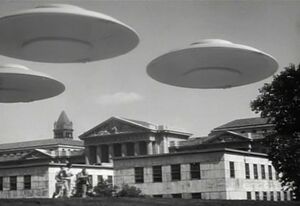
Flying Saucers are a commonly used form of transportation by various intelligent species.
History
Although objects like these have been observed in the skies throughout all of human history, with well documented examples dating back to the medieval ages at least; the term has become extremely popular since the later half of the 20th century, and is often used interchangeably with U.F.O., both terms having become virtually synonymous with "alien spacecraft", although neither is supposed to mean specifically that. Curiously, the name "flying saucer" was first coined in 1947 to refer to a formation of nine unidentified flying objects (UFOs) observed by aviator Kenneth Arnold while in flight; even though the objects described by Arnold were actually shaped more like crescents.
The concept of saucer-shaped flying craft has also been researched by multiple agencies on Earth as well; and many people still hold the belief that at least some UFO sightings originate in man-made objects that have been kept secret from the public. Another relatively popular explanation (especially among cryptozoologists) consists in the idea that at least some of the observed "flying saucers" are actually living organisms native to the higher layers of the Earth atmosphere, and which seldom, if ever, touch the ground. This idea has been written upon in detail by Leonard Cramp, Trevor J. Constable, Ivan T. Sanderson and Karl Shuker, among many others.
Occurrences in fiction
Flying saucer users
A list of species known to utilize this type of vessel for interplanetary travel:
- Adipose (Doctor Who)
- Aliens (A Centaur's Life)
- Aliens (Earth Vs. the Flying Saucers)
- Aliens (Gadget and the Gadgetinis)
- Aliens (Independence Day)
- Aliens (Invasion of the Saucer Men)
- Aliens (Teenagers from Outer Space)
- Alphans (Starship Invasions)
- Antareans (Cocoon)
- Baltians (Men In Black)
- Bugs (Men In Black)
- Colonists (The X-Files)
- Daleks (Doctor Who)
- Dexoids (Yogi and the Invasion of Space Bears)
- Dominators (Doctor Who)
- Energy Beast (The Godzilla Power Hour)
- Frunobulaxians (Pinky and the Brain)
- Greys (multiple occurrences in fiction, and possibly real life)
- Hurrians (The Gentle Vultures)
- Ice Warriors (Doctor Who)
- Kanamits (To Serve Man)
- Kilaaks (Destroy All Monsters)
- Lurons (Doctor Who)
- Martians (Devil Girl from Mars)
- Martians (Mars Attacks!)
- Martians (The Three Stooges)
- Nedenah (Doctor Who)
- Pairans (Warning from Space)
- Prin (The Lost World)
- Rigellians (The Simpsons)
- Slime Creatures (Slime Creatures from Outer Space)
- Vree (Babylon 5)
- Xiliens (Godzilla movies)
- Yargonians (Yargo)
- Zeta Reticulans (Starship Invasions)
Other occurrences
Other occurrences of flying saucers in fiction:
- The Jupiter 2, which carries the protagonists from the classic TV series Lost in Space, is an example of an Earth ship that uses this design.
- In Star Trek, many Federation ships are largely composed of a saucer-shaped section which can be separated from the rest, essentially becoming a flying saucer. This is most notably observed with the USS Enterprise-D in Star Trek Generations.
- A flying saucer has been observed in the Tintin adventure Flight 747 to Sydney, although the aliens responsible for it remain unseen.
- One such object is seen frozen in an ice cave in the animated comedy Ice Age.
- The Qarashteel use them, but not as starships, only as atmospheric probes.
- Mator's species consists of living, intelligent flying saucers.
Biological saucers
Examples of such creatures in science fiction include:
- Some of the life forms described in Sir Arthur Conan Doyle's tale The Horror of Heights.
- The creatures from the pilot episode of Star Trek: The Next Generation.
- Hedorah, when in its flying form, somewhat resembles an organic flying saucer.

